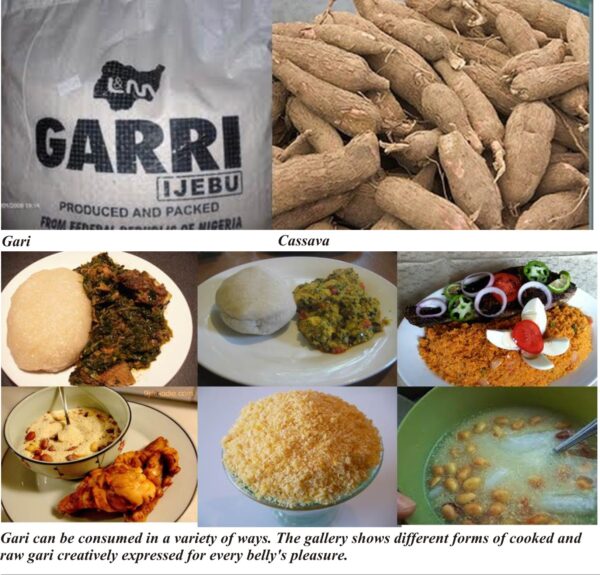Gari and Cassava production
– A small business that can change your life!
Gari and cassava production in Africa is an impressive business opportunity for the continent, especially West and Central Africa.
Cassava is one of the most popular and widely consumed food crops in Africa.
Because it is such an important food in the region and an extremely versatile crop, it is commonly referred to as cornerstone of food security in Africa.
The competing needs for cassava cut across both human and animal consumption. It is fast becoming a popular raw material in industrial production and is now a preferred material for making biofuels.
As Africa’s population and economy continues to grow rapidly, the demand for food staples like cassava has increased. This high demand for various forms of processed cassava is pushing prices to the ceiling.
Several small scale cassava farmers are making a fortune and changing their lives through this business.
Let’s explore the opportunities in cassava production and possible areas you can exploit…
First, an impressive cassava success story from Ghana
Faustina Sakyi, is a very successful Ghanian cassava farmer and Gari producer. Her story (in the video below) is a shining example of the transformational power of this business.
From her small cassava farm in a remote village, she has grown a business that sells gari beyond her country’s borders; to Mali, Niger, Togo and Nigeria.
Why is cassava an important food crop for Africa?
Cassava is highly adaptable to the African tropical climate and soils, and remains very popular for producing excellent harvests even when other crops fail. It is also the most widely available source of carbohydrates and dietary energy in Africa.
Processed forms of cassava, especially gari (or garri), fufu and tapioca, are very common throughout West Africa. Gari is hugely popular in the region as it has traditionally remained cheaper than other carbohydrate sources, especially rice and maize.
This has aptly earned it the nickname “the common man’s food”.
Gari (also Garri or tapioca) is the most widely traded processed cassava product. It is estimated that more than 75 percent of the cassava produced in Africa is processed into gari.
As a result, gari prices are often a reliable indication of the demand and supply of cassava.
However, the price of cassava and its derivatives have increased sharply in the past few years. The population explosion in Africa has made it difficult to produce enough cassava to feed many ‘common’ Africans.
In addition, the raging economic growth of China has made it the largest buyer of African cassava, which it uses as a major ingredient for animal feed for livestock (cattle, pigs etc.). China is currently responsible for more than 60 percent of global cassava consumption, and is still buying more from Africa (especially Nigeria)!
Combine the growing profile and demand for cassava as a source of biofuels and it becomes very evident that the future demand and prices for cassava is headed for the skies.
The estimated value of the global cassava trade is in excess of US$2 billion annually. However, Thailand, Brazil and Indonesia dominate the international trade in cassava.
Despite its favourable climate, fertile soils and cheap manpower, Africa is yet to fully exploit the huge returns from the global cassava trade.
Due to the very short shelf life (2-3 days) of harvested cassava tubers, inadequate road and power infrastructure, most of the cassava produced in Africa is consumed locally, where it is still unable to address the growing consumption.
As a result, a lot of the cassava harvested every year in Africa become spoilt and never make it to the market. This wastage is estimated to be worth millions of dollars every year.
Market Opportunities for Gari and Cassava production in Africa
Even for small scale entrepreneurs who are unable to participate in the international cassava export market, feeding the local African population with this most basic food stuff remains an interesting and highly lucrative prospect.
What is more interesting is that as humans, animals, industries and biofuels compete for the valuable cassava crop, the prevailing local market prices will continue to explode!
The annual consumption of gari in West Africa is valued at several million dollars (annually) and is expected to grow with the population explosion in the region. For as long as a large proportion of the population in the region remains predominantly poor, gari will continue to be the preferred food product for many years to come.
Gari has several applications in African cuisine and is prepared in very many ways across cultures and countries. It’s really well enjoyed and consumed by both rich and poor.
Of all the forms of cassava that can generate income, garri is the cheapest and easiest way for entrepreneurs to enter and exploit the processed cassava market. Gari production is a low-cost and largely traditional process and can be done on a small scale.
To produce garri, fresh cassava tubers are washed, peeled, mashed, fermented and fried to produce the coarse-grained product.
A kilogram of Garri fetches up to five times the price of an equal weight of fresh cassava. By adding value to the cassava crop and processing it into a ready-to-eat staple like gari, entrepreneurs can earn a very healthy profit on the open retail market.
In addition to the large local market for gari, there is a huge opportunity, with a much higher profit potential, in exporting this product to the increasing number of Africans living abroad in the US and Europe.
However, there are strict guidelines concerning food exported to these countries. Our article on exporting dried and smoked fish contains some helpful information if you’re interested in exporting gari to foreign markets where the demand of Africans abroad is equally huge.
Success tips for aspiring Gari and Cassava producers…
For any entrepreneur to favourably exploit the opportunities in this market, he/she may have to invest in cultivating the cassava crop on a farm. If you are sure of a steady and very cheap supply of the fresh cassava tubers, you are likely to succeed without your own cassava farm.
However, due to the high perishability of fresh cassava tubers, it may be very challenging to get the tubers to a processing centre or facility fast enough before spoilage starts.
It is also important to note that processed cassava (especially gari) is available in several different varieties. Be sure that your finished gari product appeals to the taste and tradition of your target market.
Gari in Ghana may look and taste different from Nigerian or Togo gari. Even within our different countries, there are still many different types, shades and flavours of gari.
Additives such as palm oil and soya bean are sometimes used to enrich the look, feel, taste and protein content of the product. Understanding the ‘Gari’ needs of your market (quality, packaging etc) is very important so you don’t end up with the right product in the wrong market.
Gari that is not properly processed (especially by manual methods), may not last long in storage due to its high moisture (water) content. You may choose to sell the finished product as soon as it is bagged and ready.
On the contrary, if moisture content in the finished product can be kept very low (using machine production), gari is known to last up to a year in storage and will command premium prices in the market during non-harvest periods.
Some things you should consider before you start a gari and cassava production business
A key success factor in this business is the nearness of a gari processing location to the source of your cassava tubers. Remember, if the tubers are not processed within 48 to 72 hours, cassava may start to spoil.
If your source is far from your processing area, you may have to decide on a very reliable means of transportation to get your tubers to site as soon as possible.
Second, gari production can be a very manual process but the required labour is largely available and cheap. Using labour with previous experience of gari production from the interior villages (where the practice is prevalent) will be very helpful.
However, this traditional manual production of garri is considered to be crude, uneconomic and unhygienic. Investment in cassava processing machinery may help to save a lot of costs and improve the quality of your gari.
Several machines including Cassava graters, Fermentation racks, Hydraulic presses, Automatic Garri Fryers and Vibrating Sieves are available and can make the production process hygienic and economical.
The video below shows the full range of gari processing equipment in action at a plant in the Western region of Nigeria. It shows the processes from the time the cassava tubers arrive at the plant until they are processed into market-ready gari.
This is obviously the type of facility you should look out for in your area. It’ll surely take a lot of manual labour off your hands!








